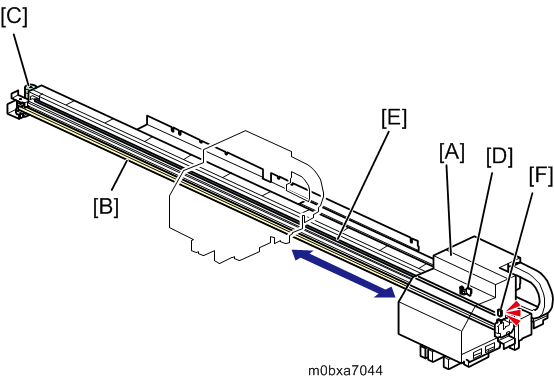Carriage Unit Drive
The carriage unit [A] is driven by the carriage drive motor [C] via the timing belt [B]. The carriage unit is controlled by the main scan encoder [D] which reads the main scan encoder seat [E] which is parallel to the linear guide.
The home position of the carriage unit is detected by the carriage home position sensor [F].

Carriage Unit Lift Mechanism
When printing under the following conditions, the media may be rubbed by the print head, causing the printed image to become dirty.
- When printing on extremely thick media
- When a large amount of ink is used and the media swells because of absorbed ink (cockling)
- When media swells because of heat caused by being left set
To prevent these from happening, how much the carriage unit is lifted can be adjusted. The customer makes adjustments from the [Print Adjustment] screen. The amount can be changed in four steps according to the paper thickness.
The lifting movement of the carriage [A] is driven by the carriage rising motor [B]. It rotates the shaft [C] in the carriage and the cam on the shaft lifts the carriage. The vertical position is controlled in four steps based on the detection of carriage rising sensor 1 [D] and carriage rising sensor 2 [E].

Carriage lift amount control
| Carriage unit lift height | Carriage Rising Sensor 1 (top) | Carriage Rising Sensor 2 (bottom) |
|---|---|---|
| 0 mm (default) | OFF | OFF |
| 0.5 mm | OFF | ON |
| 1.0 mm | OFF | OFF |
| 2.0 mm | ON | OFF |